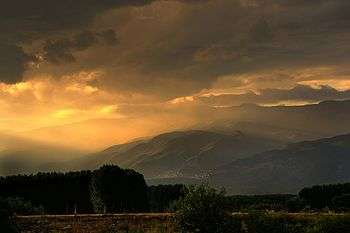Ano Poroia
Ano Poroia (Greek: Άνω Πορόια) is a village in Greece, located in Macedonia. The population was 965 people (2011).
Ano Poroia Άνω Πορόια | |
|---|---|
 Ano Poroia | |
| Coordinates: 41°17′N 23°02′E | |
| Country | Greece |
| Administrative region | Central Macedonia |
| Regional unit | Serres |
| Municipality | Sintiki |
| Municipal unit | Kerkini |
| Elevation | 380 m (1,250 ft) |
| Community | |
| • Population | 965 (2011) |
| Time zone | UTC+2 (EET) |
| • Summer (DST) | UTC+3 (EEST) |
| Postal code | 620 55 |
| Area code(s) | 23270 |
| Vehicle registration | ΕΡ |
| Website | https://www.sintiki.gov.gr/ |
Geography
The village is located 55 km and 30 km respectively to the Northwest of the town of Serres and to the west of Sidirokastro. It is at the foot of the Belles (Belasitsa) at an altitude of 380 m. Lake Kerkini is to the south of Ano Poroia.
Name
The town of Ano Poroia, is known in Aromanian as Foroi. It was known as "Poroj" during Ottoman rule.
History
Ano Poroia was founded in the end of the 18th century (c. 1800), by Aromanians (primarily) of Pindus mountain after expulsions led by Ali Pasha of Ioannina. During the 19th century the village was one of the largest and developed in Demirhisar Kaza of the Serres Sandjak. The main occupation was farming (tobacco, flax, cotton, barley, rye), sericulture, and commerce. The population was composed of Macedonians, Aromanians, Bulgarians and Turks.
In "Ethnographie des vilayets d'Adrianople, de Monastir et de Salonique" (issued in Constantinople in 1878 and concerning the population) it was written that Gorni Poroi was a village, and had 320 households with 1,000 Bulgarians and 60 Aromanians.[2] Gustav Weigand — German linguist and specialist in Balkan languages (esp. Bulgarian and Aromanian) — passed during the early 20th century. He mentions 750 households. 450 of them Bulgarian, 200 Aromanian and 100 Turkish.[3]
At first both Bulgarians and Aromanians adhered the same liturgy and they belonged to a unified church that was serving in Greek.
The oldest school that ever existed in the village is mentioned in 1819. It was a Greek elementary school that was attended by Aromanians and a few Bulgarian children of the wealthier class. The first conflict between Greeks and Bulgarians was registered in 1883, when Bulgarians tried and achieved to separate from the Greek church and education and regenerate their own. According to Vasil Kanchov, in 1891 the village had two Bulgarian churches (serving in Church-Slavonic) and an Aromanian church (serving in Greek). There were two Bulgarian elementary schools, and one Greek elementary school that was attended by Aromanians.[4] According to Kantchov, there were 3,780 people living in the village around 1900. 2,200 of them were Bulgarian, 480 were Turkish, and 1,100 Aromanian.[5]
Around the turn of the 20th century, the Bulgarian people in Gorni Poroj were within the borders of the Bulgarian Exarchate. [6] According to Dimitar Mishev, the secretary of the exarchate, in 1905 there were 3,840 Bulgarian exarchatists, 25 ethnic Greeks, and 750 Aromanians. There was a Bulgarian elementary school and a Greek elementary and middle-high school.[7]
The Bulgarian 7th Rila Division controlled the village expelling the Ottoman authorities in October 1912, during the First Balkan War. During the Second Balkan War, on July 9, 1913, the Greek army liberated the village.
After the war, the village remained within the borders of Greece. A large portion of the Bulgarian population, as well some Aromanians, emigrated to south Bulgaria. They went primarily to the towns of Petrich, Blagoevgrad, and Plovdiv, and to the villages on the northern slopes of Belasitsa, Belasitsa, Kolarovo, Samuilovo, Klyuch, Skrat. In 1913 according to the Greek statistic ministry there were 2.684 Greek Macedonians in the village (including Aromanians). In the 1920s, Greek refugees from Asia Minor settled down in the village. It was occupied again by Bulgaria in periods of 1916-1917 and 1941-1944.
Born in Ano Poroia

- Ivancho voivoda (1848–1896), Bulgarian revolutionary
- Yordan Ivanov (1908 - ?), Bulgarian chemist, professor at Sofia University
- Petros Pennas (1902–1994), Attorney,Politician - Serres, Greek historian
- Dimitrios Itsios (1906–1941), Greek soldier murdered by Nazis [8]
Notes
- "Απογραφή Πληθυσμού - Κατοικιών 2011. ΜΟΝΙΜΟΣ Πληθυσμός" (in Greek). Hellenic Statistical Authority.
- „Ethnographie des vilayets d'Adrianople, de Monastir et de Salonique“. Constantinople, 1878
- (1908): Linguistischer Atlas des dacorumänischen Sprachgebiets. Leipzig: Barth.
- Васил Кънчов. „Пътуване по долините на Струма, Места и Брегалница“.
- Васил Кънчов. „Македония. Етнография и статистика“. София, 1900.
- Доклад на Андрей Тошев, в: История на българите в документи, Съставители Величко Георгиев и Стайко Трифонов, т. І, ч. ІІ, София 1996, с. 307
- D.M.Brancoff. "La Macedoine et sa Population Chretienne". Paris, 1905, p.188-189.
- The story of Itsios-in greek Archived November 25, 2009, at the Wayback Machine